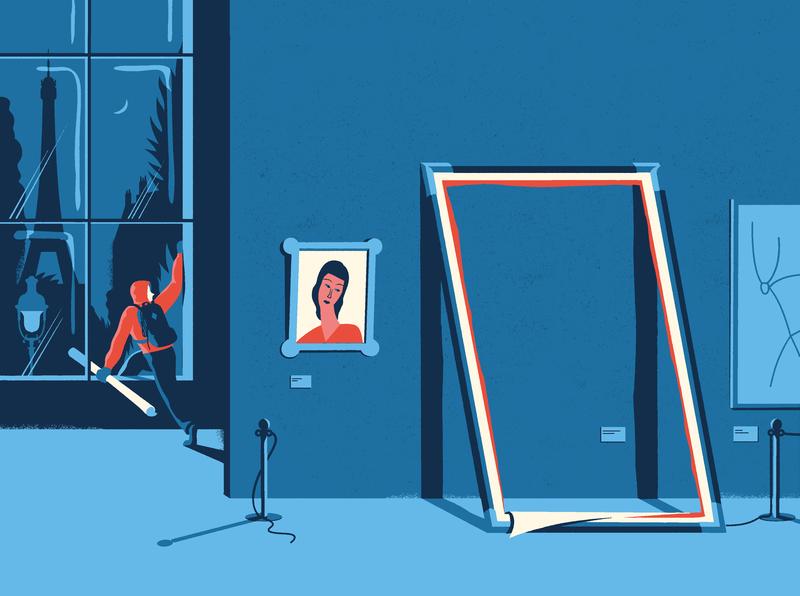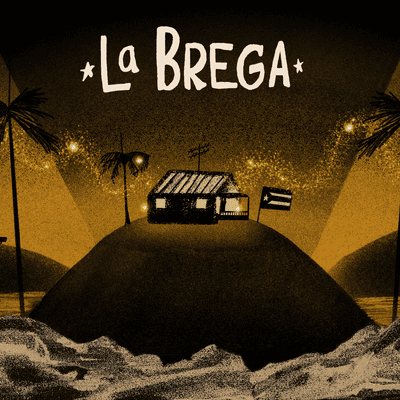For a French Burglar, Stealing Masterpieces Is Easier Than Selling Them

[music]
?Speaker 1: On a night in May 2010, some $70 million of art was stolen from a museum in Paris, in one night. For months the French police couldn't find the thief and they still haven't found the paintings. Who pulls off something like this and how? Here's contributor, Jake Halpern with a story of the thief known as the Spiderman of Paris.
[music]
Jake: It was the screw that gave it away. Vjeran Tomic was standing in the dark at night in front of a window of the MAM in Paris. That's the Museum of Modern Art. He just used his pocket knife to scrape the paint away so that he could see the screw better, examine just how it bit into the window frame. He confirmed his hunch, the frame was old-fashioned just like the window from a job he'd done before. He knew how to take it apart.
[background noise]
Jake: A few days later Tomic goes back to the MAM, the galleries were open and like everyone else, he goes into the front door, buys a ticket, and wanders around. On the walls, there are Picasso's, Kandinsky's, and some motion detectors that don't seem to be working. He makes a note, the sensors, the paintings, the windows. There's an opportunity here.
[music]
Jake: Tomic has been writing to me for a year from his jail cell in France. An actor is reading from the letters that he wrote to me.
Jean: I was a child with a devious tendency, an evil disposition. I did not speak much. I remember myself when I was seven or eight years old and cousins I lived with, I would put cactus spines in their shoes to see how much pain they could stand. I locked a friend my age in an empty barrel who were playing hide and seek. I abandoned him hoping that nobody would find him.
Jake: The press calls him Spiderman, but he says that's been his nickname since he was a kid, back when he grew up in a Bosnian mountain town, famous for its raging river and tall bridge. Local kids made a sport of climbing the rocks along the riverbank and leaping into the water.
Jean: It's a custom for us, like in Acapulco in Mexico. For me, climbing started around the age of six or seven.
Jake: That's where Tomic climbed to his first robbery. He used a ladder to get to the window of a library about 16 feet up a wall. He stole a few old books. When he was 11, Tomic left Bosnia Herzegovina for Paris. His family lived in a building that shared a wall with the Père Lachaise Cemetery where Jim Morrison, Marcel Proust, Édith Piaf, and many others are buried.
Jean: There was everything in the cemetery. Black masses at night, hippies going to Jim Morrison's grave. Hundreds of people came on pilgrimage. There were drugs everywhere, and dealer gangs would fight each other. It was our playground because it was the only thing we had, the cemetery in front of the window.
Jake: Tomic had a hard time in Paris, a hard time learning French, and money was tight for the family. His mother was disabled and his father was mean to him, cold. Tomic often ran away from home. By 12 he started stealing things to get by. He'd break into cars and steal the stereos or rummage around in the glove box. By 14, he and some friends had started breaking into apartments.
Jean: My first burglary in Paris, I used the cemetery outer wall to access the yard and climb one of the buildings. I got a gold-plated Dupont lighter with a small bag of jewels and no more than 150 francs. Did I imagine that I was going to become a famous burglar? Of course.
Jake: He got hooked.
Jean: It started as a test, like an obsession to do something more. Something was pulling me, encouraging me to do it. Later I found that there was a double personality in me, a spiritual guide. My ability to sneak into buildings is like a gift. I sometimes think for a while then as if by magic, without the magic wand, I have the formula.
Jake: The night after he uncovers the screw in the MAM window, Tomic goes back, he wears a hoodie and he walks around the outside of the museum very carefully. He has to pick the right window, and there's one just behind a parapet out of view of the security cameras.
Jean: The one on the corner of the facade that allowed me to watch over both sides of the esplanade. Nobody could see me except for a few passing cars.
Jake: Now, the museum it's across the street from the Seine. Tomic finds an inconspicuous spot to sit and he waits.
Jean: I stay there five hours to see if an internal or external security check will happen. Inside a guard shows up around three o'clock in the morning. A guard with a dog comes to the street to check the surroundings. I am not alone. The museum is not alone.
Jake: He watches for another night just to make sure that he's got the guards' routine down. Once he figures out his window and the schedule, Tomic goes back with supplies. He's got a dark piece of cloth that he hangs like a curtain outside the window to give himself cover.
Jean: It is smart and it allows me to do my job quietly without being seen.
Jake: Tomic sits and works. He uses paint stripping acid to expose the heads of each screw. Then he applies another solution to remove the rust.
Jean: I chose acid with a stripper for the frame paint, a small Dremel tool to remove the plaster where the screws are. It is necessary to sand off and clean everything. Two hours per night, six nights. There is a lot of work to be done.
Jake: Always, always, he keeps an eye on his watch. He's a pro. He's been doing this for decades. He's coming to believe that his success is part practice, but also part destiny. It's like he feels mystically drawn to the places he robs.
Jean: I also have to be in harmony with certain places. Some places pull me, something is waiting for me. Sometimes it's hard to understand what I feel so I let myself be guided by my subconscious. The luxury apartment started when I was 17 years old.
Jake: His first one is this chic building and he gets his way up onto the roof and then repels down the side to the fourth floor to the apartment that he's got his eye on.
Jean: The apartment was more than 5,000 square feet. I noticed white sheets on some dressers and furniture. All the works of art were placed on the wooden floor. There were lots of them. It looked like a museum.
Jake: Tomic didn't know anything about painting and so it didn't occur to him to take them, but he did notice a catalog for an upcoming art auction. A few weeks later he went to check it out.
Jean: That's when I realized that a month before I had at my feet everything that was in front of me at the auction. There were two Renoirs and several Ang and Degas. When I realized the prices I couldn't believe it. The famous books of Picasso and Chagall were sold for more than 800,000 francs at the time. That's how I came to like works of art because everything that was sold was worth millions.
Jake: Here's the thing, stealing art it's not the same as selling art. Stolen masterpieces are like gold that happens to be radioactive. They seem valuable but are actually dangerous and unsellable.
Jean: Jewels we're the best choice I could live off them and never be in jail, really. I got into art personally. I like paintings the most I had Degas, Renoirs, Signac, [unintelligible 00:08:57] Pissaro, [unintelligible 00:08:58] and many others. To sell them was dangerous and I never had reliable sources abroad to flag them to collectors or receivers.
Jake: Tomic got caught sometimes. In fact, he spent nearly 15 years in prison. There was one guy though who Tomic could sell to reliably. His name was Jean-Michel Covez and he ran this small gallery right in the Bastille. Corvez was a middleman. He had clients and they had particular tastes and those tastes were the basis of a kind of shopping list that he gave to Tomic. On this list, there was Basquiat, Chagall, Klimt, Pissaro, Monet. Oh, and Modigliani and Léger. They were on the list too and they were also on the walls of the MAM when Tomic strolled through the museum. After he spots these paintings, Tomic meets with Corvez.
He tells him what he's seen and Corvez says that he wants the Léger, a painting called Still Life with Candlestick. They haggled. Corvez would only pay €40,000, which was less than Tomic wanted and way less than the painting was worth, but in the end, Tomic gave in. The money was nice, of course, but for Tomic, he also just loved pulling off a clean heist. It's the early hours of May 20th. The streets are quiet. It's dark. Paris is asleep and Tomic's window is ready. He's bought two suction cups that he attaches to the glass pane, and then he uses a crowbar to ever so gently pry the window from the frame.
Jean: There is also the seismic sound alarm on each, the slightest noise can trigger it. I am very careful, especially when I move the windowpane, which is very heavy. Behind the windowpane, there is the grill padlocked with a chain which I have to open. It is not hard.
Jake: He slips into the museum and then leaves almost immediately. He goes back to the banks of the Seine, where he waits for 15 full minutes just to make sure no alarms have gone off in the museum. When it seems like the coast is clear, he climbs back through the window a second time. He takes the Léger off the wall and out of its frame. Now, this should be it. Mission accomplished, a clean job, but standing alone in the museum in the dim light and the silence, a feeling overtakes him, that old irresistible cold. He finds himself staring face to face with Matisse's Pastorale of Three Nudes reclining in a verdant setting, while a fourth figure with dark red coloring plays a flute.
Jean: It's magical. Its colors and the paint that pops out a little in relief, thick, make a beautiful work. In this painting, I saw a deep, vivid nature, much more fertile than today, and the little devil playing his flute out of nowhere, as if by magic as if he were the guardian of this environment, where hostesses, guests join in on his alluring music. I love impressionists.
Jake: He grabs it and a Modigliani, and then three more paintings. Then he spots another. It's Modigliani's Woman with Blue Eyes.
Jean: I will never forget what this woman with blue eyes did to me. When I went to get it off the wall, it told me, "If you take me, you will regret it for the rest of your life." I think when I touched it to take it out of its frame, it started instantly, a fear that came over me like an iceberg, a freezing fear. All the hair of my arms was stiff. I had to run away. That was it.
Jake: He leaves the painting on the wall. He takes the others out of their frames and carries them to his car, and he sits there for five minutes, equivocating. He's so close to the museum. He could go back for more. The window, it's still accessible. It would be so easy. Like that, he's in motion again, crossing the street back towards the museum that he's just robbed. He's stepping over a small barrier when his pants rip. A car stops at a red light a few hundred feet away and, boom, reality sets in. The streets are empty, and here he is next to the museum, wearing a hooded sweatshirt looking very much like the thief that he is. He leaves. This time, for good.
Jean: The evening at MAM could have been worse, not for me, but for them. Five was the limit. I saw the burglary of the five paintings from the MAM in my dreams 15 years earlier. I knew that someday I would do something great.
Jake: More than $70 million worth of art stolen in one night. The five paintings were some of the most important in the museum's collection. Investigators said that the thief had a sophisticated knowledge of the works. At least he had a good eye. The next morning, though, Tomic has a problem. Instead of one stolen painting on his hands, he has five. When he meets the buyer, Corvez, he only gets paid for the Léger, the painting they'd agreed on, a shoebox filled with €40,000 in small bills.
Tomic gives all five paintings to Corvez. Corvez says he'll try to sell three, no promises, but Tomic wants Matisse's Pastoral for himself. He's just leery of having it on him right now. After all, he's a convicted art thief. He's got to lay low. Sure enough, the police start watching him. As their investigation points ever towards Tomic, they begin listening in on some of his phone calls, and when they actually call his phone, they get this surreal greeting.
Jean: If you want to buy paintings or works of art or exceptional jewelry, do not hesitate to contact me. Among the lot of paintings, there are also five that are extremely expensive, so we can discuss.
Jake: Tomic is so eager to sell the other paintings that he's actually advertising them to people who call, and he's bragging a bit too. The police, they need more than just an outrageous phone message to arrest Tomic. They need material evidence. About a year goes by and Tomic needs money, but such as money he needs, he wants his Matisse back from Corvez. On the upside, he's not in jail. Maybe even the MAM robbery will go unsolved, and he'll eventually get some money for the rest of the MAM paintings that he'd given to Corvez, but Tomic robs this other apartment and he gets busted.
This time, he stole some watches and a Pissarro. When the police search Tomic's apartment, they find the stolen jewelry, a bunch of watches, climbing equipment. They also found paintings, but not the ones from the MAM. When the police questioned him, Tomic confessed to the latest apartment robbery, but then the police tell him that just a couple of days earlier, they'd question Jean-Michel Corvez too. Tomic, he gets paranoid.
Jean: I could not believe it. Maybe he wanted me to go to jail so he walks away. With people like Corvez, you will quickly rot in a very deep hole for the rest of your life.
Jake: He is totally worried that Corvez is going to pin the entire MAM job on him, a lie about the fact that it was Corvez himself who commissioned the robbery in the first place. Not just that, what if Corvez would get off and keep the paintings, or worse yet, what if he'd already sold them without giving Tomic any money?
Jean: I had been waiting for a year. I thought he had already sold all my works. It was a nightmare. The question is to know where the works really are right now.
Jake: If Tomic confessed to his part and told them everything he knew about Corvez, maybe at least the police would find the art.
Jean: For me, the trial was the solution to make the paintings reappear. Maybe they are still alive, but well hidden.
Jake: At trial, Corvez said he'd pass them along to someone else, another middleman who then testified that he'd panicked and thrown them into the trash. Yes, the trash. In France, there's no penalty for lying on the stand, and Tomic doesn't believe that Corvez or the middle man told the truth. I got to wonder how honest Tomic was with me. He seemed to really love telling his story, but sometimes I felt like he was toying with me, just reveling in the mystery that he had, in fact, created. Sometimes he seems to think that whoever has the paintings will give them up.
[music]
Jean: One day or another, he will be forced to give them to the person to whom they belong. That is to say, me.
[music]
?Speaker 1: The letters of Vjeran Tomic were read for us by the actor Jean Brassard. Jake Halpern's most recent book is Welcome to the New World. It's based on his Pulitzer Prize-winning story about a Syrian refugee family.
[music]
[00:19:53] [END OF AUDIO]
Copyright © 2024 New York Public Radio. All rights reserved. Visit our website terms of use at www.wnyc.org for further information.
New York Public Radio transcripts are created on a rush deadline, often by contractors. This text may not be in its final form and may be updated or revised in the future. Accuracy and availability may vary. The authoritative record of New York Public Radio’s programming is the audio record.





